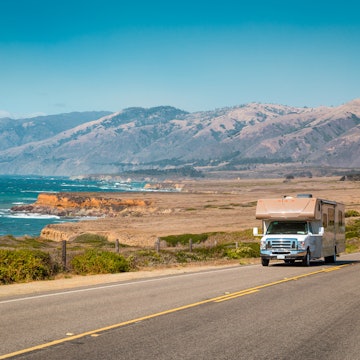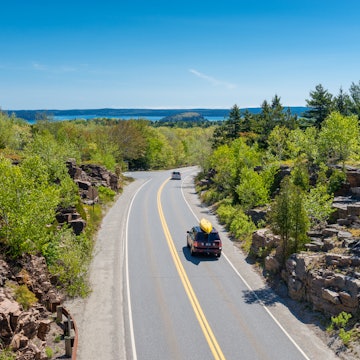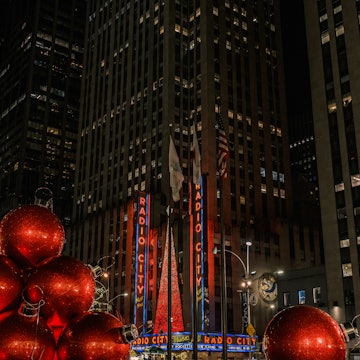

Away from Midtown’s skyscrapers, amazing neighborhoods are what make New York City a world capital. Jon Bilous/Shutterstock
With more than 8 million people crammed into five boroughs, New York City is a boisterous metropolis that famously refuses to sleep.
Its riot of sights and sounds can vary so much from one block to the next – let alone from borough to borough – that you could take a full month to visit a different part of town each day, and you’d merely scratch the surface.
Home to Times Square, Rockefeller Center, the Empire State Building and the Theater District, Midtown is an obvious destination for first-time visitors. But don’t stop there – an endless amount of urban life exists to discover after you’ve crossed those icons off your list.
Here are eight New York City neighborhoods any visitor should make time to explore. And make sure to read our tips on where locals go, too.

1. Harlem
Best neighborhood for Black culture
Harlem has been the epicenter of Black culture in America since the early 1900s – an efflorescence that truly took off in the 1920s, when the Harlem Renaissance kicked off a decade of unparalleled artistic expression.
Spanning the worlds of politics, music, literature, art, dance and more, luminaries including Marcus Garvey, Langston Hughes, Louis Armstrong, Zora Neale Hurston and Duke Ellington took the spotlight, laying the groundwork for the Civil Rights movement and paving the way for future such creative forces as James Baldwin, Maya Angelou, Miles Davis, Charlie “Bird” Parker and Dizzy Gillespie.
Today, those interested in the neighborhood’s history have plenty of options. At the New York Public Library’s Schomburg Center for Research in Black Culture, selections from the personal collections of prominent artists and activists are available to the public, while the National Jazz Museum pays tribute to the genre’s past and present.
Langston Hughes’ former home on East 127th St has been listed on the National Register of Historic Places since 1982, while the Sugar Hill Children’s Museum of Art & Storytelling offers workshops and programs to keep the little ones entertained.
You can also spend an evening at Minton’s Playhouse, where jazz greats from Miles, Bird and Dizzy to Duke Ellington, Ella Fitzgerald and Billie Holiday once performed – or opt for something a bit more of the moment at the iconic Apollo Theater (its famous amateur night has been an incubator of new talent for decades). Sylvia’s Restaurant is renowned for its soul food, while Marcus Samuelsson’s Red Rooster puts a modern spin on classic comfort fare. (Read Samuelsson's top places to visit in the city.)
Where to stay in Harlem: Northern Lights

2. East Village and Lower East Side
Best neighborhood for restaurants
South of 14th St and east of Bowery is the East Village and Lower East Side, once celebrated for its grungy punk-rock scene but now better known for its stylish vibe – albeit one that retains a hint of an edge. Thanks to the plethora of restaurants, bars, shops, theaters and concert venues that have sprung up in the past decade or two, it’s just a bit harder to see the grit.
St Marks Place is one of the East Village’s main drags. You’ll find plenty of tacky stores and cheap vendors here, as well as some real gems hiding in plain sight, especially as you travel further east toward Tompkins Square Park; we love the Moroccan-inflected Cafe Mogador and speakeasy Please Don’t Tell.
Yet no matter which block you stumble down, it’s hard to go wrong. And everywhere, you’re sure to find something tasty, whether it’s blintzes and pierogi from the legendary Veselka, a cardamom bun from La Cabra, a delicious bowl of Thai noodles from Soothr, or cheeseburger tacos and spicy cucumber margaritas from Empellón al Pastor come happy hour.
On the other side of Houston and stretching down toward Chinatown, the Lower East Side is a neighborhood molded by immigrants, a fascinating history best experienced at the superb Tenement Museum on Orchard St. The New Museum and the International Center of Photography Museum are also nearby.
On Houston itself, two institutions nod to the area’s Jewish roots: Katz’s Delicatessen, equally beloved for its smoked pastrami and its appearance in the “I’ll have what she’s having” scene from When Harry Met Sally; and Russ & Daughters, a traditional “appetizing” shop known for its caviar, knishes and smoked fish.
Further south on Orchard, Scarr’s Pizza grinds its own stone-milled flour to make the perfect unpretentious slice, while Dirt Candy on Allen St serves ultra-creative vegetarian food. To sample a little bit of everything, check out Essex Market, which features vendors from around the neighborhood and across the city.
Where to stay in the East Village and Lower East Side: The Ludlow, Citizen M

3. West Village
You might have seen New York a few times in movies. And while every corner of the city is photogenic in its own way, one neighborhood seems to get star billing more frequently than anywhere else: the West Village. Given its quaint, shady blocks, well-maintained brownstones, and chic boutiques, bars and restaurants, it’s easy to see why it’s been the home of so many memorable fictional characters.
The neighborhood is best seen on foot – so grab a latte from one of the many local coffee shops (we’re partial to Bonsignour), put on your best paparazzi-repelling sunglasses and prepare to lose yourself in the picturesque streets.
Follow the tour buses to 64 Perry St, which served as the stand-in for Carrie Bradshaw’s apartment on Sex and the City (even though Carrie was meant to live on the Upper East Side; go figure) – then walk a few blocks south to 90 Bedford St, where you’ll find the Friends apartment. Further east, Mad Men’s Don Draper kept an apartment at 104 Waverly Pl, by ever-vibrant Washington Square Park.
The park itself is a celluloid stalwart too, having appeared in films from Ghostbusters II to Inside Llewyn Davis. The legendary town commons of the Village is also a celebrity favorite itself: none other than David Bowie called it his favorite place in New York.
Where to stay in the West Village: The High Line Hotel, The Standard (High Line)

4. Jackson Heights, Queens
Best neighborhood for traveling internationally without a passport
Located in north-central Queens just a short train ride from Midtown Manhattan, Jackson Heights is said to be the most diverse neighborhood of the most diverse borough of New York City. Some 60% of the neighborhood’s 180,000 residents were born outside the US, and 167 languages are reportedly spoken here.
The area is primarily Latino, with representation from Mexico, Colombia, Peru and Bolivia, as well as Nepal, Tibet, India, Pakistan and Bangladesh. Jackson Heights also has one of New York’s most vibrant LGBTIQ+ communities, and it plays host to the New Queens Pride Parade each June.
With the 7 train rumbling overhead, Roosevelt Ave comes off as a bit scruffy – but its lineup of Tibetan, North Indian and Colombian fare makes it well worth a stroll, as does its assortment of stellar taquerias. But to get a real feel for the neighborhood vibe, head north to family-oriented 37th Ave, where you’ll find dosas and arepas alongside Uruguayan sweets and Brazilian boutiques, among other mom-and-pop shops catering to the ultra-diverse locals.
Where to stay near Jackson Heights: Boro Hotel, Ravel Hotel

5. Chelsea
Best neighborhood for LGBTIQ+ travelers
Greenwich Village has been a hub of LGBTIQ+ life in New York for centuries (a pilgrimage to the Stonewall Inn, where rioters in 1969 sparked a revolution in civil rights, is rewarding for human beings of all sexual identities) – and stalwarts like Julius’, Marie’s Crisis and Cubbyhole continue to draw queer folk to the area
Yet Chelsea, just to the north, might have the edge.
Spanning the blocks from 14th to 23rd Sts and Sixth Ave to the Hudson River, Chelsea is home to queer-owned and -run shops, galleries and restaurants, as well as gay bars galore. At Barracuda, you’ll find drag shows and two-for-one drinks; Rebar is a go-to for dancing and debauchery, while the Eagle hosts a leather scene unlike any other.
In between cocktails, soak up some culture with a gallery hop (there are countless spaces in the area, most of which are free), then get some fresh air with a stroll along the High Line. This former freight railway turned elevated park offers a different, and thoroughly enchanting, perspective on the neighborhood.
Where to stay in Chelsea: The Chelsea Hotel

6. Upper East Side
Best neighborhood for museums
Just a short subway ride away from downtown’s buzz, the Upper East Side has an air of quiet sophistication that makes it feel like a whole different city, from its gracious beaux-arts buildings to its (relatively) peaceful, tree-lined streets.
It’s a mix of Michelin-starred restaurants and fancy cocktail bars butting up against burger joints and dive-y sports bars; moneyed families, young professionals and blue-collar workers sharing sidewalk space; and upscale boutiques facing nationally known chains.
For visitors, museums are the main attraction here: the area boasts the highest concentration of cultural institutions in the city. In the shadow of Central Park, Fifth Ave’s Museum Mile stretches from 70th St at the elegant Frick Collection, which is reopen following a major expansion, past 82nd St and the world-famous Metropolitan Museum of Art to the lesser-known El Museo del Barrio at 104th. In between, there’s the Jewish Museum, the Museum of the City of New York, the Guggenheim and the Cooper-Hewitt Smithsonian Design Museum, among others.
Where to stay in the Upper East Side: The Franklin, The Carlyle

7. Chinatown
Best neighborhood for budget travelers
Bordered by Little Italy and the Lower East Side, Chinatown is like no other place in the city, with heavily trafficked streets and sidewalks packed with fruit-and-vegetable stands, vendors pushing designer knock-offs and swarms of people in every direction.
The options for accommodations here are limited – the Hotel 50 Bowery is a boutique property with a great rooftop bar, the Leon Hotel has views of the Manhattan Bridge, and there’s a Best Western and a Wyndham Garden in the vicinity. But you’ll have no problems sticking to a budget otherwise, thanks to the inexpensive souvenir shops and, most importantly, the inexpensive dining options.
Think dim sum parlors, pho joints, hot-pot spots and ice cream shops. Bakeries selling sesame balls, custard tarts and pork buns. Holes-in-the-wall slinging hand-pulled noodles, thin-skinned dumplings and crisp-skinned roast duck. All of which means you can easily eat well here without breaking the bank. Just be sure to bring cash, as many places in the neighborhood won’t take cards.
Where to stay near Chinatown: Broome Hotel, Dominick Hotel, Soho Grand Hotel

8. Williamsburg and Bushwick
Best neighborhood for live music
The hipster haven of Williamsburg isn’t exactly an under-the-radar destination – it’s been luring people across the East River for decades now, and even as it’s gone mainstream, the area still appeals. The neighborhood is peppered with stylish boutiques and eateries, and its music scene is one of the best in town.
On North 6th St, indie favorites take the stage at the Music Hall of Williamsburg, while a few doors down, the innovative performance space National Sawdust provides an intimate setting for a diverse range of talent, from string quartets and experimental artists to established stars like David Byrne and Liz Phair.
On Wythe Ave is Brooklyn Bowl – part bowling alley, part concert venue – and on Bedford is the Williamsburg Music Center, a Black-owned jazz club that’s been around since 1981 – practically an eternity in New York’s ever-shifting nightlife landscape.
If Williamsburg is the elder statesman, Bushwick to the east is the young up-and-comer, full of stylish spots (often in former warehouses) to drink, dance, see a show or simply mingle with the good-looking crowds. To tear it up on the dance floor, hit Jupiter Disco, Lot 45, Mood Ring or the Bossa Nova Civic Club; to catch your favorite band, try Elsewhere, Alphaville or Market Hotel.
Where to stay in Williamsburg: Penny, Wythe Hotel
















